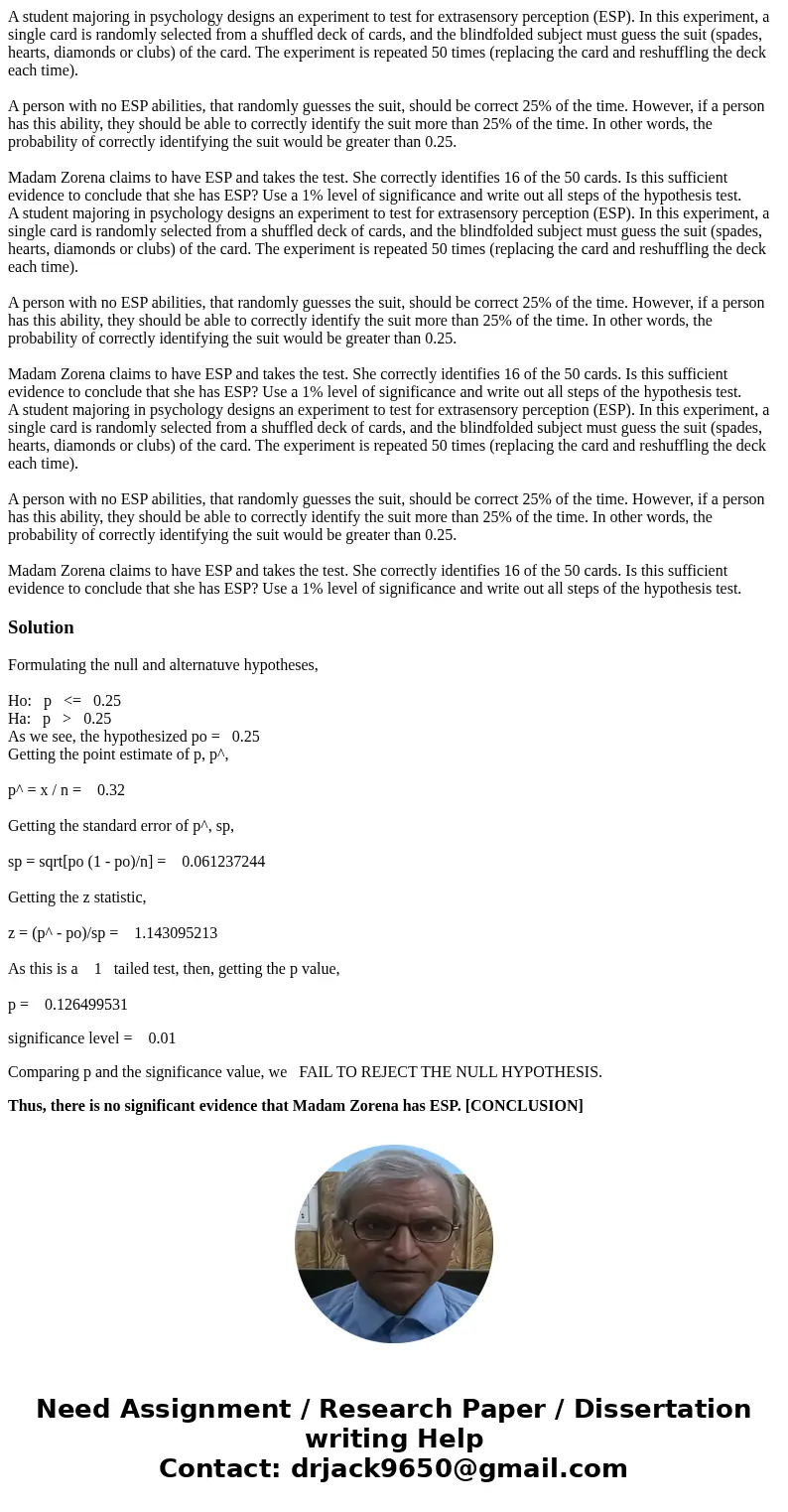A student majoring in psychology designs an experiment to test for extrasensory perception (ESP). In this experiment, a single card is randomly selected from a shuffled deck of cards, and the blindfolded subject must guess the suit (spades, hearts, diamonds or clubs) of the card. The experiment is repeated 50 times (replacing the card and reshuffling the deck each time).
A person with no ESP abilities, that randomly guesses the suit, should be correct 25% of the time. However, if a person has this ability, they should be able to correctly identify the suit more than 25% of the time. In other words, the probability of correctly identifying the suit would be greater than 0.25.
Madam Zorena claims to have ESP and takes the test. She correctly identifies 16 of the 50 cards. Is this sufficient evidence to conclude that she has ESP? Use a 1% level of significance and write out all steps of the hypothesis test.
A student majoring in psychology designs an experiment to test for extrasensory perception (ESP). In this experiment, a single card is randomly selected from a shuffled deck of cards, and the blindfolded subject must guess the suit (spades, hearts, diamonds or clubs) of the card. The experiment is repeated 50 times (replacing the card and reshuffling the deck each time).
A person with no ESP abilities, that randomly guesses the suit, should be correct 25% of the time. However, if a person has this ability, they should be able to correctly identify the suit more than 25% of the time. In other words, the probability of correctly identifying the suit would be greater than 0.25.
Madam Zorena claims to have ESP and takes the test. She correctly identifies 16 of the 50 cards. Is this sufficient evidence to conclude that she has ESP? Use a 1% level of significance and write out all steps of the hypothesis test.
A student majoring in psychology designs an experiment to test for extrasensory perception (ESP). In this experiment, a single card is randomly selected from a shuffled deck of cards, and the blindfolded subject must guess the suit (spades, hearts, diamonds or clubs) of the card. The experiment is repeated 50 times (replacing the card and reshuffling the deck each time).
A person with no ESP abilities, that randomly guesses the suit, should be correct 25% of the time. However, if a person has this ability, they should be able to correctly identify the suit more than 25% of the time. In other words, the probability of correctly identifying the suit would be greater than 0.25.
Madam Zorena claims to have ESP and takes the test. She correctly identifies 16 of the 50 cards. Is this sufficient evidence to conclude that she has ESP? Use a 1% level of significance and write out all steps of the hypothesis test.
Formulating the null and alternatuve hypotheses,
Ho: p <= 0.25
Ha: p > 0.25
As we see, the hypothesized po = 0.25
Getting the point estimate of p, p^,
p^ = x / n = 0.32
Getting the standard error of p^, sp,
sp = sqrt[po (1 - po)/n] = 0.061237244
Getting the z statistic,
z = (p^ - po)/sp = 1.143095213
As this is a 1 tailed test, then, getting the p value,
p = 0.126499531
significance level = 0.01
Comparing p and the significance value, we FAIL TO REJECT THE NULL HYPOTHESIS.
Thus, there is no significant evidence that Madam Zorena has ESP. [CONCLUSION]

 Homework Sourse
Homework Sourse